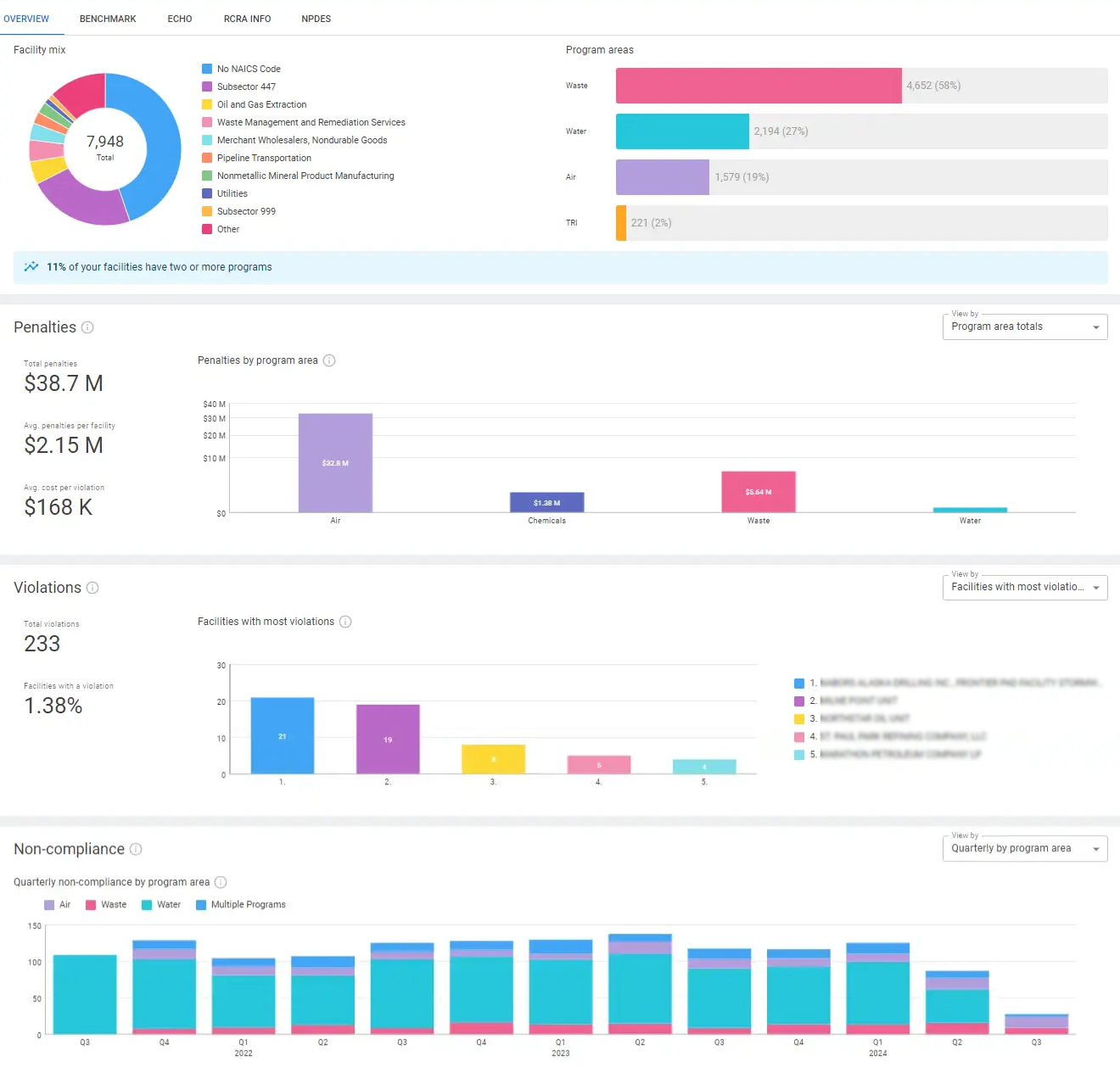How Insights Works
Encamp's Insights feature is a powerful tool that provides organizations with valuable information about their facilities' environmental compliance by integrating with external databases maintained by the U.S. Environmental Protection Agency (EPA).
Insights offers a comprehensive view of a company's compliance program, enabling users to benchmark their performance against industry peers and competitors, and identify potential areas for improvement.
EPA's Compliance Databases
The EPA maintains a vast array of databases that store environmental compliance information for regulated facilities across the United States, with the intent of promoting transparency and accountability by making compliance data accessible to the public.
These databases include:
Enforcement and Compliance History Online (ECHO): ECHO is a publicly accessible database that provides integrated compliance and enforcement data for regulated facilities.
Resource Conservation and Recovery Act Information (RCRAInfo): RCRAInfo is the national database that tracks hazardous waste handler activity and compliance.
Integrated Compliance Information System - National Pollutant Discharge Elimination System (ICIS-NPDES): ICIS-NPDES contains information on facilities regulated under the Clean Water Act's NPDES program.
Air Facility System (AFS): AFS contains compliance and permit data for stationary sources of air pollution regulated by EPA and state and local air pollution agencies.
These databases contain an enormous amount of data, including permit information, inspection findings, violations, enforcement actions, and penalties assessed. However, navigating these disparate databases and compiling the relevant information can be an extremely time-consuming task for organizations with a high number of facilities.
How Encamp and Insights helps
Encamp's Insights feature is a more efficient and user-friendly way to access and analyze environmental compliance data compared to navigating EPA's databases directly. Insights simplifies the process by integrating data from multiple EPA databases, including ECHO, RCRAInfo, and ICIS-NPDES, into a single, easy-to-use platform.
This eliminates the need for users to search through each database separately and manually compile the relevant information for each facility in their organization. Additionally, Insights provides a more intuitive interface and powerful analytics tools that enable users to quickly identify trends and compare organizational performance to industry and competitors.
With Insights, users can spend less time gathering and organizing data and more time analyzing it to make informed decisions about their environmental compliance strategies; and by linking your facilities in Encamp with their records in ECHO, you can ensure that your compliance data is always up-to-date and accurate.
Covered Program Areas
Insights covers three main environmental program areas:
Waste: Insights includes data on hazardous waste handlers regulated under RCRA, such as LQGs, SQGs, VSQGs, and TSDFs.
Water: Insights covers data on surface water dischargers regulated under the NPDES program, including major and non-major facilities, as well as facilities covered under general permits.
Air: Insights provides data on air emissions from stationary sources regulated under the CAA, including major sources (Title V facilities), synthetic minor sources, and federally-reportable minor sources.
Use Cases for Insights
Insights can be used for a variety of purposes, including:
Compliance Monitoring: Users can easily monitor their facilities' compliance status across multiple environmental programs.
Benchmarking: Insights allows users to compare their facilities' compliance performance against industry averages and specific competitors, providing context for their own compliance efforts.
Auditing: The feature can be used to support internal auditing processes, helping users identify potential red flags and areas requiring further investigation at their own facilities, vendors, or potential merger and acquisition targets.
Stakeholder Communication: Insights can help users communicate their compliance performance to stakeholders, such as investors, regulators, and the public, by providing a clear and comprehensive view of their environmental compliance history.
Data Update Frequency
EPA updates the data in their federal databases on varying schedules, depending on the specific system:
Many systems, including ECHO, are updated weekly.
Some systems are updated quarterly.
For more obscure systems, updates may occur yearly.
Detailed information on refresh rates for ECHO data can be found on the EPA's "About the Data" page.
Encamp refreshes its Insights data weekly, pulling from these systems every Tuesday. This ensures that users have access to the most current information available from the EPA.
However, users should be aware that there may still be a lag time between when an event occurs (e.g., an inspection or violation) and when that information appears in EPA datasets. This is due to the time it takes for states, local agencies, and tribes to report information to EPA's national databases. In some cases, this lag could be several weeks or months.
Read our article Understand common ECHO issues to learn about some of the limitations of ECHO's data set.

